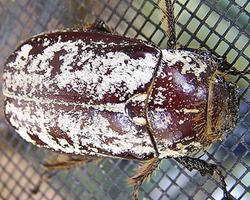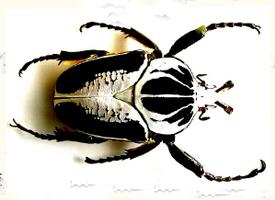
Starea de conservare
| Amenințat |
Descrierea animalului
The Cane Beetle, scientifically known as Dermolepida albohirtum, is a species of beetle that plays a notable role in the ecosystems of Australia, particularly in regions where sugarcane is cultivated. This beetle belongs to the Scarabaeidae family, which includes a vast array of species often characterized by their robust bodies and remarkable strength. The Cane Beetle is no exception, showcasing a sturdy build that is well-suited to its lifestyle.Adult Cane Beetles are easily recognizable by their sizeable, oval bodies that can reach up to 25 millimeters in length. They possess a hard exoskeleton that is predominantly black in color, with a distinctive covering of white hairs (setae) that gives them a somewhat speckled appearance. This unique feature not only contributes to their common name but also serves as a form of camouflage among the sugarcane fields they inhabit.
The life cycle of the Cane Beetle is fascinating, involving several stages from egg to adult. Females lay their eggs in the soil near the base of sugarcane plants, where, upon hatching, the larvae, commonly referred to as "grubs," begin their development. These grubs are creamy white in color, with a C-shaped body that is typical of many beetle larvae. They are voracious feeders, primarily targeting the roots of sugarcane plants, which can lead to significant agricultural damage if populations are not managed effectively.
As the larvae mature, they undergo a process of metamorphosis, eventually emerging as fully developed adults. The adult beetles are nocturnal and are often seen flying around lights at night. Their diet shifts from the roots consumed in their larval stage to the leaves of the sugarcane plant, although the damage caused by adults is generally less significant than that of the larvae.
The Cane Beetle's association with sugarcane cultivation has made it a pest of economic concern in Australia. Over the years, various control measures have been employed to manage beetle populations and minimize crop damage. These have included the use of chemical pesticides, the introduction of biological control agents, and the development of resistant sugarcane varieties.
Despite their status as pests, Cane Beetles are an integral part of their native ecosystems. They contribute to nutrient cycling through their feeding and burrowing activities, which helps to aerate the soil. Furthermore, they serve as a food source for a variety of predators, including birds and other insects, thereby playing a role in the broader ecological community.
In conclusion, the Cane Beetle, Dermolepida albohirtum, is a species with a complex life cycle and significant impact on its environment. While it poses challenges for sugarcane agriculture, it also exemplifies the intricate relationships between species and their habitats, highlighting the importance of sustainable pest management practices that balance agricultural needs with ecological conservation.
Animale similare
Fotografii noi cu animale
Top 10 animale
- Dolphin gull (Leucophaeus scoresbii)
- Diana monkey (Cercopithecus diana)
- Moustached guenon (Cercopithecus cephus)
- Stone loach (Barbatula barbatula)
- Greek tortoise (Testudo graeca)
- Galápagos tortoise (Geochelone nigra complex)
- Japanese macaque (Macaca fuscata)
- Russian tortoise (Testudo horsfieldii)
- Common flying dragon (Draco volans)
- Galápagos penguin (Spheniscus mendiculus)


